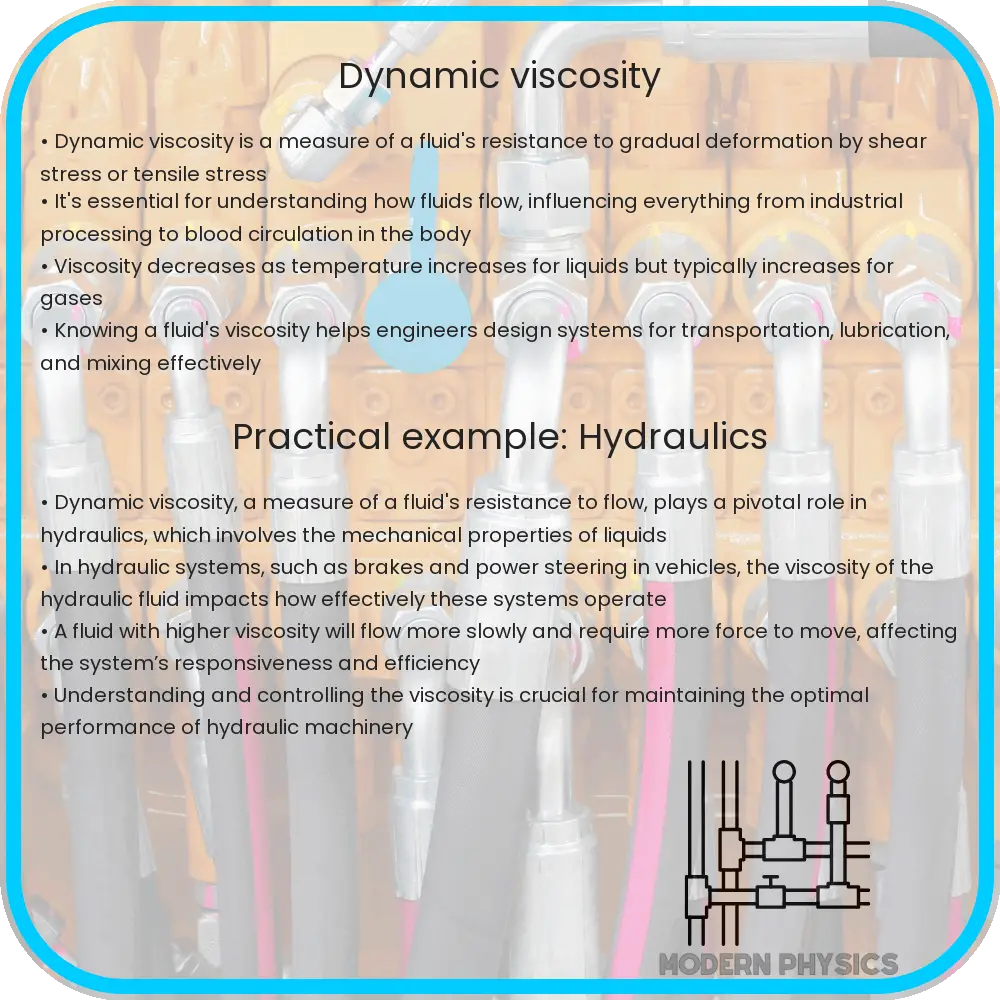Explore the fundamentals of dynamic viscosity, its measurement techniques, factors affecting it, and diverse applications in various industries.

Understanding Dynamic Viscosity: Essential Concepts
Dynamic viscosity, often simply referred to as viscosity, is a fundamental property of fluids which measures their resistance to flow. It plays a crucial role in a wide range of industries and applications, from lubrication in automotive engineering to the flow of blood in the medical field. In this article, we explore the measurement of dynamic viscosity, the factors that affect it, and its various applications.
Measurement of Dynamic Viscosity
The SI unit for measuring dynamic viscosity is the Pascal-second (Pa·s), though the more common unit is the centipoise (cP), especially in the field of chemistry. Measurement techniques vary depending on the fluid type and the required precision. Common methods include capillary viscometers, where the time taken for a fluid to flow through a capillary tube is measured, and rotational viscometers, which measure the torque required to rotate an object in the fluid.
Factors Affecting Dynamic Viscosity
Several factors can influence the viscosity of a fluid:
- Temperature: For liquids, viscosity typically decreases with increasing temperature. In the case of gases, viscosity increases with temperature. This is due to the enhanced molecular mobility at higher temperatures.
- Chemical Composition: The type of molecules in a fluid and their interactions significantly impact its viscosity. For instance, long-chain polymers increase viscosity.
- Pressure: In most liquids, viscosity slightly increases with pressure, but the effect is more pronounced in gases.
The relationship between these factors and viscosity can be described using mathematical models. For example, the Arrhenius equation gives a basic representation of the temperature dependence of viscosity:
\[ \eta = A \times e^{\frac{E_a}{RT}} \]
where \(\eta\) is the viscosity, \(A\) is a pre-exponential factor, \(E_a\) is the activation energy for flow, \(R\) is the gas constant, and \(T\) is the temperature.
Applications of Dynamic Viscosity
Understanding and controlling the viscosity of fluids is essential in many industries. In the automotive industry, the viscosity of engine oil is critical for efficient lubrication. In the food industry, the texture and spreadability of products are often dictated by their viscosity. The pharmaceutical industry relies on viscosity measurements to ensure the consistency and efficacy of liquid medications.
Additionally, viscosity plays a key role in environmental science, particularly in the study of ocean currents and the movement of pollutants in water and air. Its importance extends to engineering fields such as aeronautics and materials science, where the flow properties of liquids and gases are fundamental to design and manufacturing processes.
Advanced Techniques in Viscosity Measurement
Advancements in technology have led to more sophisticated methods for measuring dynamic viscosity. Rheometers, for instance, are used for fluids with complex properties, like non-Newtonian fluids, where viscosity changes under stress or over time. Ultrasonic viscometers, which measure the speed of sound through a fluid, offer non-invasive and rapid measurements.
Microfluidics technology also plays a significant role in viscosity measurement at small scales, essential in biochemical and medical research. These technologies not only provide more accurate measurements but also allow for the exploration of viscosity under varied conditions and in more complex fluids.
Role of Dynamic Viscosity in Research and Development
In research and development, dynamic viscosity is a key parameter in formulating new products and materials. For instance, in the paint and coatings industry, the right viscosity ensures proper application and finish. In biomedical research, understanding the viscosity of bodily fluids can lead to better diagnostic tools and treatments.
Moreover, in the field of nanotechnology, the manipulation of viscosity at the nano-scale opens up possibilities for innovative applications, such as targeted drug delivery systems and the development of new materials with unique flow properties.
Environmental and Safety Considerations
Viscosity measurements also have environmental and safety implications. In environmental monitoring, understanding the viscosity of pollutants helps in predicting their movement and impact. In the petrochemical industry, the viscosity of oils and fuels is critical for safe handling and efficient processing. Accurate viscosity measurements can prevent accidents and ensure compliance with environmental regulations.
Conclusion
Dynamic viscosity is not just a physical property of fluids but a pivotal factor in numerous scientific, industrial, and environmental contexts. Its measurement, influenced by factors like temperature, pressure, and chemical composition, requires precise techniques ranging from simple viscometers to advanced rheometers. The significance of dynamic viscosity spans various industries, including automotive, pharmaceutical, food, and environmental science. As technology advances, so does our understanding and control of this crucial property, leading to safer, more efficient processes and innovative applications in science and engineering. The continuous exploration of dynamic viscosity remains essential in our quest to harness and optimize the behavior of fluids in an ever-evolving technological landscape.
